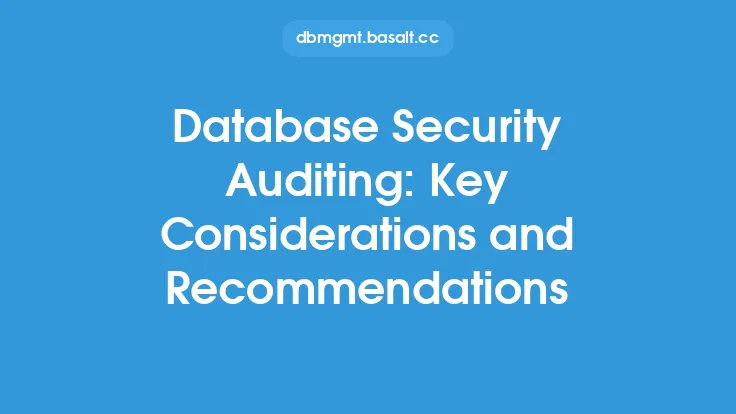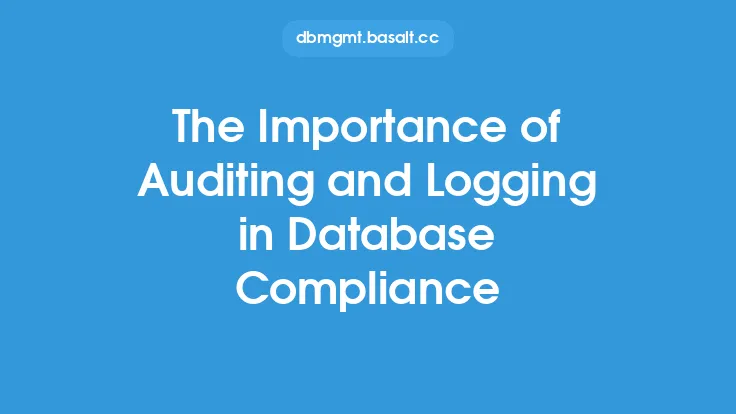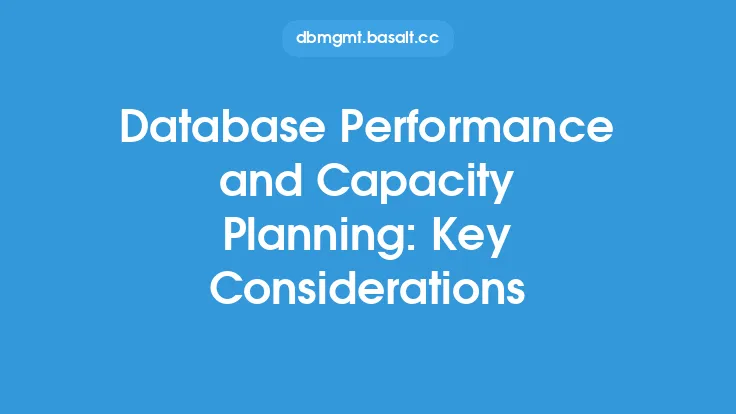Database auditing and logging are essential components of database administration, as they provide a record of all activities performed on the database, helping to ensure the integrity, security, and performance of the data. Auditing and logging involve tracking and recording database events, such as login attempts, queries, and data modifications, to detect and respond to potential security threats, troubleshoot issues, and optimize database performance.
Introduction to Database Auditing and Logging
Database auditing and logging are related but distinct concepts. Auditing refers to the process of tracking and recording database events to detect and respond to security threats, while logging refers to the process of recording database events to troubleshoot issues and optimize performance. Both auditing and logging are critical components of database administration, as they provide a record of all activities performed on the database. This record can be used to identify potential security threats, troubleshoot issues, and optimize database performance.
Types of Database Auditing and Logging
There are several types of database auditing and logging, including:
- Database-level auditing: This type of auditing involves tracking and recording database events at the database level, such as login attempts, queries, and data modifications.
- Object-level auditing: This type of auditing involves tracking and recording database events at the object level, such as tables, views, and stored procedures.
- User-level auditing: This type of auditing involves tracking and recording database events at the user level, such as user login attempts and queries executed by a specific user.
- System-level logging: This type of logging involves recording system-level events, such as system startup and shutdown, and system errors.
Database Auditing and Logging Techniques
There are several database auditing and logging techniques, including:
- Native auditing: This technique involves using the database management system's built-in auditing capabilities to track and record database events.
- Third-party auditing tools: This technique involves using third-party tools to track and record database events.
- SQL logging: This technique involves recording SQL statements executed on the database to troubleshoot issues and optimize performance.
- Transaction logging: This technique involves recording database transactions to ensure data integrity and recover from failures.
Benefits of Database Auditing and Logging
Database auditing and logging provide several benefits, including:
- Improved security: Auditing and logging help detect and respond to potential security threats, such as unauthorized access and data breaches.
- Enhanced troubleshooting: Logging helps troubleshoot issues and optimize database performance by providing a record of database events.
- Compliance: Auditing and logging help organizations comply with regulatory requirements, such as HIPAA and PCI-DSS.
- Data integrity: Transaction logging helps ensure data integrity by providing a record of database transactions.
Challenges and Limitations of Database Auditing and Logging
Database auditing and logging also present several challenges and limitations, including:
- Performance overhead: Auditing and logging can impact database performance, particularly if the auditing and logging mechanisms are not optimized.
- Data volume: Auditing and logging can generate large volumes of data, which can be challenging to manage and analyze.
- Complexity: Auditing and logging can be complex, particularly in large-scale databases with multiple users and objects.
- Cost: Auditing and logging can require significant resources, including hardware, software, and personnel.
Best Practices for Database Auditing and Logging
To get the most out of database auditing and logging, organizations should follow best practices, including:
- Implementing a comprehensive auditing and logging strategy: This involves identifying the types of events to track and record, and the frequency of auditing and logging.
- Using native auditing capabilities: This involves using the database management system's built-in auditing capabilities to track and record database events.
- Optimizing auditing and logging mechanisms: This involves optimizing auditing and logging mechanisms to minimize performance overhead and data volume.
- Regularly reviewing and analyzing audit logs: This involves regularly reviewing and analyzing audit logs to detect and respond to potential security threats, and troubleshoot issues.
Tools and Technologies for Database Auditing and Logging
There are several tools and technologies available for database auditing and logging, including:
- Database management systems: Most database management systems, such as Oracle and Microsoft SQL Server, provide built-in auditing and logging capabilities.
- Third-party auditing tools: There are several third-party auditing tools available, such as IBM InfoSphere Guardium and Imperva SecureSphere.
- Logging tools: There are several logging tools available, such as Splunk and ELK Stack.
- Cloud-based auditing and logging services: There are several cloud-based auditing and logging services available, such as Amazon CloudWatch and Google Cloud Logging.
Conclusion
Database auditing and logging are essential components of database administration, providing a record of all activities performed on the database to detect and respond to potential security threats, troubleshoot issues, and optimize database performance. By understanding the types of database auditing and logging, techniques, benefits, challenges, and limitations, organizations can implement a comprehensive auditing and logging strategy to ensure the integrity, security, and performance of their databases.





